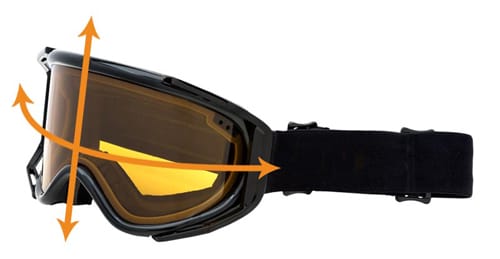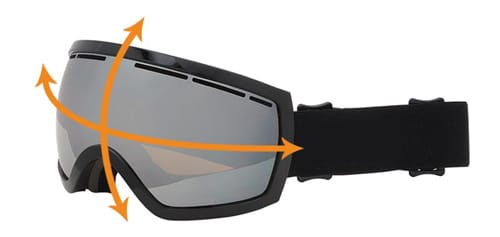
-

First and foremost, ski goggles provide reliable eye protection from wind and cold air, which keeps your eyes from tearing up as you blast down the slopes. They also keep flying snow and other debris out of your eyes. If you choose a pair that fits well, your ski goggles should create a snug, comfortable and virtually air-tight seal against your face. This provides much better protection against wind compared to sunglasses.
UV Protection
Goggles provide another very important service: protection from harmful UV radiation. All goggles from reputable brands should provide 100% protection from both UVA and UVB. Because the snow reflects sunlight, your eyes can actually be exposed to even higher levels of UV on the slopes. For this reason, everyone should consider wearing goggles when skiing, snowboarding or participating in other winter sports, like snowmobiling.
Polarized Lenses
Although the vast majority of goggles will block UV, not all will cut glare caused by light reflecting off the snow and ice. In the mountains, reflected glare can contribute to eye fatigue, making it harder to see clearly as the day goes on. To help stop glare, look for goggles with polarized lenses. Polarized goggles use special lens technology to prevent glare from reaching your eyes.
Photochromic and Polarchromic Lenses
Photochromic lenses actually adjust the tint according to changing light conditions. In other words, as the day gets brighter, these lenses will darken to reduce light transmission. If clouds roll in and conditions get darker, the tint will lighten, allowing more light to pass though, making it easier to see the terrain. Polarchromic lenses combine photochromic properties with a glare-blocking polarization filter.
Fog Resistance
Unlike sunglasses, which have a pair of single lenses, the majority of ski and snowboard goggles have two lenses layered on top of each another with air space in between. This “double lens” design works much like a double-paned window, preventing temperature differences between the outside and inside of the goggles from fogging up the lenses. Most ski goggles have small vents in the frame, which allow internal moisture vapor to escape, further minimizing condensation buildup. For even better protection, many brands also include special anti-fog coatings for yet another defense against condensation.
-
There are two primary types of goggle lenses available on the market: cylindrical and spherical. Both have some pros and cons that are worth considering before you start shopping.
Cylindrical Lenses

This type of lens curves from right to left as it arcs across the face. In other words, the horizontal plane of the lens is curved. However, the lens’s vertical plane is flat. Although this design provides great eye protection, it doesn’t offer quite the same level of optical clarity as a spherical lens. This is partly because our eyes are curved on both the horizontal and vertical planes. On the plus side, goggles with traditional cylindrical lenses are generally more affordable, which is helpful if you’re on a budget.
Spherical Lenses

This type of lens curves on both the horizontal and vertical planes, just like our eyes. A spherical design offers better optical clarity compared to the more traditional cylindrical design. This lens style also provides slightly enhanced peripheral vision. The only real drawback to spherical lenses is a slightly higher price tag, since these lenses are more costly to produce.
-

Lens tint is another important aspect to consider when choosing ski goggles. Both the color and tint will determine the amount of light that passes through the lens to your eyes (i.e. light transmission). Check out the chart below to get an idea of what tints are best for certain conditions.
Goggle Lens Tint Chart
Lens Tint Light Transmission Best For Dark Gray, Brown Low Bright Conditions Copper, Light Gray, Green, Blue Medium Moderately Bright Conditions Yellow, Amber, Rose High Low Light and Overcast Conditions Clear Very High Night Interchangeable Goggle Lenses
Ski goggles with interchangeable lenses are a popular choice because they allow you to easily adjust light transmission according to the conditions. If light conditions change, you can simply pop in a different lens and keep on trucking. Extra lenses are lightweight and can easily be stored inside a jacket pocket or backpack.
-

Choosing ski or snowboard goggles that fit well can have a big impact on your comfort level. If your goggles are too small or too large, they may not feel comfortable on the face or they may not create a good seal against wind. Most ski goggles come in one size and have a “medium fit,” which will comfortably fit most average-sized adult men and women. Some brands also make models with a “small fit” or “large fit,” designed for smaller faces and larger faces respectively. Several optics brands also offer children’s goggles designed specifically for kids.
How to Adjust Your Goggle Strap
Ideally, the strap on your goggles should be tightened enough to maintain a good seal, but not so tight that it puts uncomfortable pressure on your forehead, nose or cheeks. If the strap is too loose, the goggles may shift around or slide down your face as you ski over bumpy terrain. If the strap is too tight, you’ll most likely experience uncomfortable pressure within the first hour or so. It may take several adjustments to find the ideal fit. It may also take some time to get used to the feel of a new pair, especially if you’ve never worn ski goggles before.
Helmet Compatibility
Because ski helmets are now considered standard equipment by most skiers and snowboarders, the majority of modern snowsport goggles are “helmet compatible,” which means they will fit comfortably underneath the brim of your ski helmet. It’s pretty uncommon to find a ski helmet and goggles that simply can’t be worn together. If you prefer the most seamless fit possible, however, it’s usually a safe bet to buy goggles and a helmet from the same brand. A few popular brands that offer both eyewear and helmets include Smith, Giro, Anon and Bern. For more info on protective headwear, check out our Helmet Guide.
Prescription Eyewear Compatibility
If you wear prescription eyeglasses and plan to wear them underneath your ski goggles, you’ll want to look for goggles with “OTG” in the product name. This stands for “over the glasses.” OTG goggles are designed with slightly more room inside the frame to accommodate prescription eyewear. If you wear contacts, regular goggles should work just fine.
How to Clean Your Ski Goggles
The majority of ski goggles have polycarbonate lenses. Although they’re quite durable, polycarbonate lenses can scratch relatively easily. Always store your goggles in a soft, microfiber bag or in a case lined with microfiber. Always wipe your lenses with a clean microfiber cloth. Other materials can potentially cause small abrasions to form over time. Never use household cleaners or solvents on your eyewear. This could damage the lenses or the protective coatings. If you’re having trouble getting your lenses clean, wash them with warm water, a few drops of mild, non-abrasive dish soap and a microfiber cloth. Be sure to rinse and dry the lenses thoroughly after.